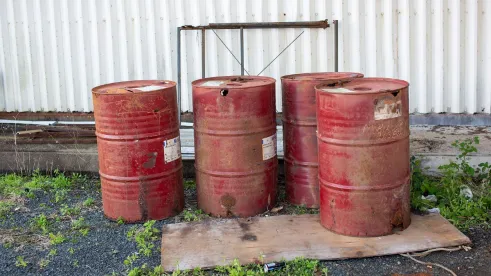Key Takeaways
-
What Is Happening? The U.S. Environmental Protection Agency (EPA) published a proposed rule requiring certain facilities to prepare Facility Response Plans (FRPs) for responding to worst case discharges of Clean Water Act (CWA) listed hazardous substances. The proposed rule is available for public comment through May 27, 2022.
-
Who Is Impacted? Affected industries include oil and gas extraction, mining, manufacturing, textiles, warehousing and storage, gas stations, and waste management facilities, among others, that are located near navigable waters and can store any of the 296 CWA listed hazardous substances at or above threshold amounts.
-
What Should I Do? Facility owners and operators, and related trade associations, potentially affected by the proposed rule should consider submitting public comments by the May 27, 2022 deadline.
The proposed rule seeks to expand the scope of facilities required to prepare FRPs, and the scope of substances to be addressed by FRPs, under the CWA. Currently, CWA regulations only require an owner or operator of a facility that could reasonably be expected to cause substantial harm to the environment by discharging oil into navigable waters to prepare and implement a FRP for responding to a worst case discharge of oil. The proposed regulations expand this to require facilities to evaluate harm caused by any of the 296 CWA listed hazardous substances. Where, based on a facility’s location, it is reasonably expected that there could be substantial harm to the environment through a discharge into navigable waters, the facility must prepare and implement a FRP for responding to a worst case discharge of CWA listed hazardous substances. The proposed rule includes criteria to determine the applicability of the rule and whether a facility can cause substantial harm.
Background
The proposed rulemaking is in response to the settlement of a 2019 lawsuit brought by the Natural Resources Defense Council, among others, which asserted EPA is required to, but failed to, issue regulations “requiring non-transportation-related substantial-harm facilities to plan, prevent, mitigate and respond to worst case spills of hazardous substances.”1
The Consent Decree requires EPA to take final action on a rule addressing worst case discharge plans for hazardous substances by September 2022.
Applicability Criteria
As a threshold matter, the proposed rule only extends to onshore “non-transportation-related” facilities (i.e., facilities not subject to the Department of Transportation’s jurisdiction). As currently drafted, there are two ways an onshore “non-transportation-related” facility can be required to prepare, submit, and implement a CWA hazardous substance FRP for worst case discharges under the proposed rule.
First, facilities that can reasonably be expected to cause substantial harm to the environment based on their location are required to prepare, submit, and implement FRPs.
-
Initial Screening. EPA is proposing two initial screening criteria to determine whether a facility could cause substantial harm to the environment from a worst case discharge into navigable water.
-
The first screening criteria determines whether a facility can store CWA hazardous substances onsite at or above a threshold quantity (10,000x the CWA Reportable Quantity).
-
The second screening criteria determines whether the facility is within one-half mile of navigable water or a conveyance to navigable water.
If a facility meets the two screening criteria, the facility must undergo an evaluation to determine if it meets the substantial harm criteria.
-
Substantial Harm Criteria. A substantial harm evaluation includes determining whether the facility meets one of the following four substantial harm criteria:
-
The ability to adversely impact a public water system;
-
The ability to cause injury to fish, wildlife, and sensitive environments;
-
The ability to cause injury to public receptors; and/or
-
A reportable discharge of a CWA hazardous substance within the last five years.
If both screening criteria and one or more substantial harm criteria apply, the facility must prepare an FRP.
Second, an EPA Regional Administrator can require the owner or operator of the facility to prepare, submit, and implement an FRP based on the consideration of site-specific factors for a facility, regardless of whether a facility meets the criteria proposed above. These factors include: threshold quantity; facility location; ability to cause injury to fish, wildlife, and sensitive environments; ability to adversely impact a public water system; ability to cause injury to public receptors; and a reportable discharge history.
EPA’s summary of the applicability criteria follows:

Implementation and Enforcement
EPA is proposing the following implementation and enforcement terms:
-
Compliance Dates. Existing facilities that meet the criteria above will have 12 months from the final rule’s effective date to submit an FRP to EPA. After the regulation has gone into effect, newly regulated facilities will have six months to submit an FRP and newly constructed facilities must submit a plan before starting operations.
-
Appeals Process. If facility owners or operators disagree with EPA’s determination of significant and substantial harm, or disapproval of a CWA hazardous substance FRP they will be able to appeal the decision by submitting a request for reconsideration. The Regional Administrator must evaluate requests for reconsideration as soon as practicable.
-
Stakeholder Petitions. EPA’s proposal includes a petition process to allow the public and other government agencies opportunities to provide input on CWA hazardous substance facilities they think should be required to submit an FRP. Petitions must include a discussion of how the criteria apply to the facility in question. The Regional Administrator must consider and respond to such petitions as soon as practicable.
Public Comment
The CWA hazardous substance worst case discharge planning regulations are available for public comment through May 27, 2022. Operators and trade associations impacted by the proposed changes may want to consider submitting public comments.
[1] Complaint for Declaratory and Injunctive Relief, Environmental Justice Health Alliance for Chemical Policy Reform v. EPA, No. 1-19-cv-02516 (S.D.N.Y., filed March 21, 2019). Section 311(j)(5)(A)(i) if the CWA directs EPA to issue regulations that require certain facilities to prepare and submit to EPA “a plan for responding, to the maximum extent practicable, a worst case discharge, and to a substantial threat of such a discharge, of oil or a hazardous substance.” 42 U.S.C. § 1321(j)(5)(A)(i).








 />i
/>i

